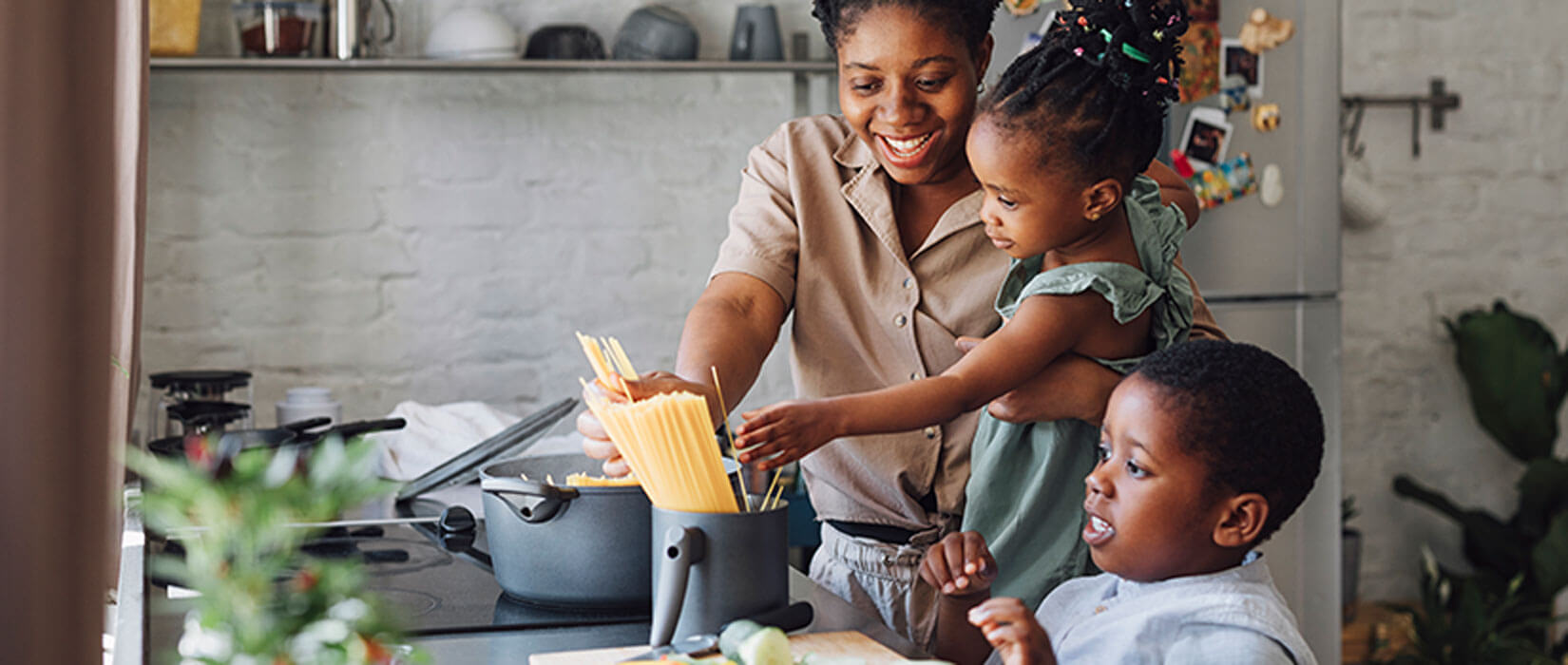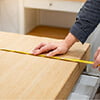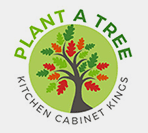Cooks of All Ages: Cooking Activities for Kids + Printables

If you're planning on starting a cooking adventure with your kids, then you've come to the right place. Cooking is a great way for your child to build confidence, learn healthy habits, and become adventurous eaters.
We're here to help you get started with the best cooking activities and safety tips for kids. To encourage your little one's cooking journey, we've included printables so they can track each new skill they learn along the way.
Although we included cooking activities based on age, it's important to remember that all children develop and learn at different paces. With this in mind, make sure to customize your chart to match your child's individual skills. Remember that the most important part of spending time in the kitchen together is to have fun during this bonding experience.
Toddler (2-3 years)
Cooking with toddlers is a great way for them to gain better motor skills with their hands and build confidence as they get better at completing tasks. It's important to remember that at this age, toddlers will need a lot of guidance and supervision while completing cooking tasks.
When cooking with a toddler, make sure to clear your kitchen of any hazards that they could touch or grab. This includes everything from sharp objects and pot handles to hot liquids and cleaning products.
Cut out the rewards stickers and place them on each new cooking activity as your little one completes them. Once they've completed each task let them collect a fun reward for becoming a master chef. We suggest making the reward something you can do together like baking cookies or going to their favorite restaurant.


Cooking Activities For Toddlers
Take advantage of your toddlers' natural curiosity and let them explore the world of cooking. Here are some fun and age-appropriate cooking activities for toddlers.
- Unloading groceries
- Washing fruits and vegetables
- Kneading dough
- Mashing potatoes with a fork or potato masher
- Squeezing citrus on dishes
- Decorating cookies
- Stirring room temperature ingredients
Pro Tip: While you can use these age guidelines for activities with your young children, it's important to remember that every child matures differently. Let your child move at a pace that feels safe and comfortable for them.
Kindergarten (4-6 years)
Once your little chef enters kindergarten, you might notice that they naturally want to start being a part of your favorite hobbies. As they begin learning their ABCs and 123s, why not continue building their confidence by helping them upgrade their cooking skills?
Kids this age will still need a great deal of supervision in the kitchen but can start getting more involved in food preparation. Remember that being safe and having fun is the most important ingredient in a successful dish.
Knife Safety Tip: It goes without saying that a knife can be dangerous for kids. However, by demonstrating safe knife skills and teaching your kids early on how to handle a knife, they can grow to be more confident.
Let your little chef get creative by creating his very own recipe book. Let him choose a recipe he recently learned how to make and have them write the instructions and draw the ingredients. After a while, he will have a treasure trove of fun recipes to come back to time and time again.


Cooking Activities For Kindergarteners
As your kiddos start learning to read and write in kindergarten, let them practice their new skill by reading simple recipes. While every child is different, here are some cooking activities that may be appropriate for kids under seven.
- Setting the table
- Whisking eggs
- Rolling dough
- Picking herbs
- Greasing or lining pans
- Measuring and pouring ingredients
- Filling muffin trays with batter
Pro Tip: A great way to get kindergarteners excited about cooking is to watch cooking videos together. Let them choose their favorite recipe to make for your next dinner or dessert.
Elementary (7-10 years)
Once your child graduates kindergarten and heads into elementary school (time flies!), they're ready to take on additional responsibilities. Now that your little sous chef is getting older, it'll be easier for them to concentrate, which will make them more excited to dive into more difficult recipes.
This is a great time to teach your child how to make parts of their school lunch and discuss food hygiene. A good place to start is by teaching them to make a peanut butter and jelly sandwich and the importance of refrigerating perishables.
Knife Safety Tip: Demonstrate to your kids how to hold and use a knife while explaining how to avoid getting hurt. Be sure your kids have the safety rules memorized before they practice, and supervise them along the way. It's helpful to start with a sturdy plastic knife and soft foods before graduating to a chef's knife.
Cooking Activities For Elementary Age Kids
Now that your kitchen helper is old enough to read recipes and fine-tune their motor skills, they can become an even greater help in the kitchen. Below are some additional cooking skills they can learn to master between first and fourth grade.
- Reading and following recipes
- Using a can opener
- Packing up leftovers
- Loading and unloading the dishwasher
- Making sandwiches for their school lunch
- Toast bread
- Using a standing mixer
Pro Tip: Try using kid-friendly knives when your child feels comfortable in the kitchen. Child-proof knives are sharp enough to cut through food but rigid enough to keep your hands safe.
Preteen Cooking Activities (ages 11-13)
By now, your preteen will start to become a master chef in the kitchen. As they mature, you can start to give them some more independence to cook on their own or with friends.
This doesn't mean they won't still need a little assistance from time to time. While they are at an age where they can follow recipes, you should always stay close in case they need help with intricate knife work or hot utensils.
Knife Safety Tip: After teaching your elementary school child the basics of holding a knife, you can now move on to more advanced methods for your preteen:
- Handle Grip - Grip the knife so your whole hand is completely on the handle. This grip is comfortable and safe for beginner cooks and littler hands.
- Pointer Finger Grip - Grip the knife with your fist and line your index finger along the top to keep your hand steady as you chop.
Make sure your kids can clearly see what they're cutting. The countertop should be at about waist height -- use a step stool if needed.
Cooking Activities For Preteens
Check out these tips on age-appropriate cooking activities to try with your preteen in the kitchen.
- Baking in the oven
- Sauteeing on a stovetop
- Decorating cakes with frosting
- Peeling vegetables
- Using the microwave unsupervised
- Washing dishes and putting them away
- Using a knife to chop
Pro Tip: If you're going through those difficult preteen years and are finding it harder to connect with your teen then cooking together is a great hobby to bond over.
Teenagers (ages 14+)
Once your child has mastered basic cooking skills they'll be ready to step up their skills for more advanced recipes. Teenagers can start to move on from making simple scrambled eggs and premade cookies to improvising in the kitchen.
While it's smart to be close to avoid any accidents, many teens can start cooking on their own or baking with their friends for fun. At this age, you might realize that your little helper's cooking skills might even start to surpass your own.
Knife Safety Tip: It's important to practice knife safety with your teenager before they leave your home after high school.
If you start to practice cutting skills with your teen, use these additional helpful guidelines:
- Keep your eyes down at your cutting board to focus.
- Hold the knife firmly with your hand angled up and the knife blade facing down.
- Make sure all fingers are tucked in and out of the way.
- The food you're cutting should be firmly placed against the cutting board. If you need to move your food, set your knife down flat and away from the edge.
- Be sure the point of the knife stays on the cutting board as you chop. Cut slow and steady with a rocking motion.
Cooking Activities For Teenagers
After you've taught your teenager basic safety skills, let them try out these additional cooking skills.
- Making recipes on the stovetop
- Chopping ingredients
- Planning out meals
- Learning about food hygiene
- Baking with friends
- Learning to use different kitchen gadgets
Pro Tip: Even if your teenager isn't interested in cooking, it's important to teach them cooking basics and basics of food science before they head off to college. This way they don't get sick after preparing their first meal in their new dorm or apartment.
Benefits of Cooking With Your Kids
Many of us helped our parents decorate cookies, stir pancake batter, or make smoothies as kids. What many of us didn't realize was that there are many benefits kids learn when they help out in the kitchen.

Here are some of the valuable benefits of parents cooking with kids:
- Enhances Motor Skills: Stirring soups, whisking batter, and squeezing citrus can help fine-tune your little one's motor skills.
- Helps Kids Learn Math: If you cook with your kids regularly, they'll start to understand the measurement of cups, teaspoons, and tablespoons in no time.
- Encourages Family Bonding: Choose a day of the week where your family comes together to try out new recipes. This time will help increase your bond and give your family a fun hobby.
- Boosts Confidence: Your child will gain more self-esteem each time they're able to master a new cooking skill or recipe.
- Improves Reading Skills: While kids are starting to learn how to read, having them help out with saying recipes out loud is a great way to practice their skills.
- Increases Focus: Cooking helps increase focus because your children will need to pay attention or they'll miss a step in the recipe.
- Encourages Healthy Eating: Trying out recipes together will encourage your children to try healthy foods they normally would want to skip out on.
Start planning new cooking activities with our rewards chart or customizable cookbook to start letting your children reap the benefits of cooking together.
Cooking Safety Tips
Before you get to the fun of cooking with your children, it's important to establish clear safety rules and guidelines. These safety measures will help avoid any injuries in the kitchen and will teach your kids to follow directions.

Kitchen Safety Tips for Kids
Kitchen safety and supervision are top priorities when cooking with your kids. Consider what tasks are appropriate for their age and development level. A three-year-old, for example, may not have the motor skills to saute veggies in a hot pan but should be fine to rinse fruit or tear lettuce.
Remind your kids what's safe and what's not safe to touch in the kitchen. Burns can happen easily -- so use caution near the stovetop, oven, and hot pots or pans. Regardless of your child's age, be sure to supervise them if they are in charge of a step that involves heat.
Remind your children to use a potholder or oven mitt to protect their hands when they carry and move hot items. Be sure to turn a hot panhandle towards the stovetop versus facing out to avoid bumping into it.
Food Safety Tips for Kids
Little hands can carry big germs. Explain that clean hands are important for food safety and preparation. It helps prevent the spread of harmful bacteria to the food and avoids them from getting sick.
As a first step, roll up your little one's sleeves and pull back any long hair.. Wash both hands thoroughly with warm soapy water for 20 to 30 seconds. Wear an apron if you'd like to protect your kid's clothes from spills.
Teach your youngster that raw meat, poultry, seafood, or eggs should be kept separate from other ingredients and to always wash their hands right after touching these foods. To prevent bacteria from spreading, clean any surfaces used to prepare these foods immediately with warm soapy water.
Explain that they should always cover their mouth and nose with an elbow or tissue if they have to cough or sneeze, so the germs don't spread to the food.
Regularly cooking with your kids is a great way to engage their senses and spend time together in the comfort of your own kitchen. It can help develop motor skills, hand-eye coordination, and life skills they will use as they grow older. They'll grow to become an adventurous happy eater and eventually be the one cooking you a delicious meal all by themselves.

























